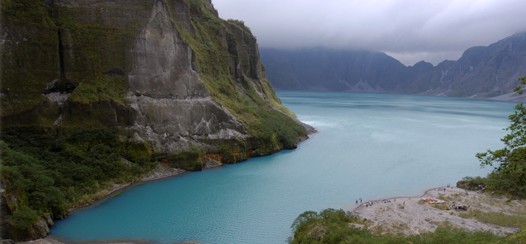The Gentle Tasaday: A Stone Age people in the Philippine rain forest (1975) by John Nance
Rating: 




In the mid-1970’s, worldwide attention focused on a twenty-five-member tribe living in the dense jungle of Mindanao in the southern Philippines, said to have been living indefinitely in isolation. Their discovery led to the forming of several expeditions composed of Filipino and American anthropologists, news correspondents, television crews of the National Geographic Society, a cabinet minister of the Philippine government, and an American conservationist, the late Charles A. Lindbergh.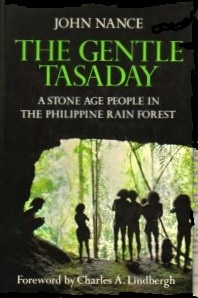
Discovery of the Tasaday was unremarkable. Sometime in 1962, a hunter from a town at the forest’s edge stumbled upon them while laying his wild-pig traps deep in the mountains of South Cotabato. As related, following a trail of strange footprints, he came upon three small men wearing only loin coverings made of leaves. With sharp sticks they were digging up a large root.
Although the tongue spoken by the hunter was related to that of the Tasaday, he resorted to sign language because of difficulty in communicating. The hunter’s tribe practically lives back-to-back with the Tasaday, but the difference in their languages was compared to that between early German and today’s English. Scientists deduced that this suggests an isolation of about a thousand years. Why, the very name ‘Tasaday’ (pronounced Taw-sawdai) was said to combine the Malay word sadai (“abandoned”) and the Malayo-Polynesian word tawo (“man”)! Tasaday is also the name of the forested peak rising above their hidden valley. So complete has been their isolation that, when first contacted, they knew nothing about a nation called the Philippines.
The existence of this tribe became known to outsiders through the efforts of PANAMIN, an agency working for the interests of cultural minorities in the Philippines. As in the Amazon and elsewhere, there is a desperate need for the right help. During early meetings between the hunter and the tribesmen at the forest’s edge, it was not known that they lived in caves, and there were no immediate attempts to go deep into the rain forest. The latter decision to visit the caves was made to protect the Tasaday from loggers, farmers, ranchers and miners who were nibbling away at their shrinking realm. They were to prove a very real threat. The Gentle Tasaday (1975) gives a comprehensive picture of the threat to the tribespeoples..
March 23, 1972, marked the intrusion of the first outsiders—and of the twentieth century—into the world of the Tasaday.
They were met by a young Tasaday man wearing only his leaf G-string. An hour’s hike down a ridge and along a sparkling stream brought the party to the home of the Tasaday: three limestone caves located 15 feet (5 meters) from the ground at an altitude of 4,500 feet (1,370 meters). Here they were, deep inside a tropical rain forest—damp and teeming with plant life. All around were giant ferns and orchids, rattan, climbing bamboo, wild banana and palm, as well as huge, towering dipterocarp trees shooting skyward to spread their canopies a hundred feet (30 meters) or more above the sides of the sloping valley.
Heads poked curiously from the ledges of the caves, as eyes scrutinized the first strangers ever to set foot in this hidden valley. A boy stepped from one of the caves, wrapped his arms and legs around a slender, white-barked tree and slid fifteen feet (5 meters) to the ground. He joined others who were shouting and bounding down a dusty path to cluster around the visitors. The outsiders were speechless as the scene unfolded! Here were men, women and children wearing only earrings and orchid-leaf G-strings and skirts, a handsome people with tanned skin and soft dark hair. The tribe was composed of five families with thirteen children.
A close look at the caves, the biggest of which was thirty feet deep and thirty-five feet wide (9 x 11 meters), was revealing. The walls had no drawings or markings, and the floor is swept clean by branches, leaving no debris. There was no furniture, except for a few bark mats. Also on hand were pieces of dried firewood and some bamboo, wooden and stone tools. The cave walls appeared to gleam like varnished coal due to years of exposure to soot from the fires used for cooking and heating the caves during the chilly evenings.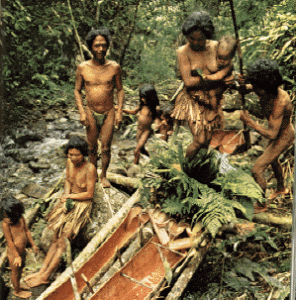
The gathering of food constitutes the day’s major activity, and it required team effort. Normally three hours were spent in foraging, and the menu depends upon what they can gather: crabs, fish and tadpoles, which the Tasaday catch simply by feeling under and around stream rocks with their bare hands. The people had no knowledge of agriculture, gathering only what they need when it was available. Their diet included fruits, berries, flowers, bamboo shoots, yams and the pith of the wild palm prepared into a starch cake called natak. Food was cooked inside bamboo tubes or in leaf packets placed right on top of the glowing coals. Incidentally, fire was made by rotating a wooden drill between the palms until friction causes its base to smolder. Then tinder of dry moss was applied, and when this ignites, it was blown into a flame. The whole process took about five minutes.
Perhaps due to the abundance of food, the Tasaday do not stray from their habitat, like the nomadic tribes who move on when food runs out. It is said that they have not ventured more than five miles (8 kilometers) from their home. “Our fathers and grandfathers told us we could go out into the forest at daytime, but must always return to the caves at night,” said one of them. It was thought that perhaps misunderstanding, war or fear of the smallpox plague (fugu) caused the Tasaday to cut off contact with the other Manobo tribes from which they originated.
With the midday meal over, the afternoon was spent resting, sleeping or ridding one another’s hair of dry leaves, twigs or lice. At play, one boy was seen flying a pet butterfly on a string, much as one would fly a kite. Their needs are simple, and they have no words for rice, salt, sugar, needle or tobacco. Although the Tasaday diet seemed low in calories (1,000 to 1,500 a day), among them there was no signs of malnutrition, no tooth decay, no malaria and no tuberculosis.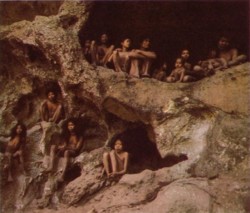
John Nance was one of the group on that day in March 1972, and his book, The Gentle Tasaday describes in detail their initial contact, their terror at the sight of the helicopter, their curiosity about the outside world, and also the efforts to protect them from the outside world. Nance covered the Vietnam War for the Associated Press beginning in 1965, spending several years based in the Phillipines as a reporter and photographer. His book is certainly a fascinating account, full of information about the tribespeople. There is no grounds to conclude he knew anything of the deception he reported on, and only time will fully reveal how much is of value. He died on March 9th 2010, aged 74. John Daniszewski, of Associated Press said: “John Nance represented a generation of great press reporters who covered the war in Vietnam and then went on to chronicle the incredible story of the Stone Age people in the Philippines.. he’s remembered as a gentleman and a wonderful raconteur, and he will be missed very much.”
In April 1972, then Philippine President Ferdinand Marcos declared 19,000 acres (182 km²) of land surrounding the Tasaday’s ancestral caves as the Tasaday/Manobo Blit Preserve. By this time, eleven anthropologists had studied the Tasaday in the field, but none for more than six weeks, and in 1976, Marcos closed the preserve to all visitors.
One of the reasons for the closing was a number of suspicions that arose. Elizalde claimed that among the remaining Tasaday, there was no wife-sharing, adultery, or divorce. Apparently, their dead were left in the forest under a layer of leaves, yet no bones or other remains were found. Although the Tasaday had claimed to be living in the jungle at their cave-shelter full time, there was no garbage or sign of human waste. Their diet was claimed to be all forage, i.e., wild fruit, palm pith, forest yams, tadpoles, grubs, and roots. The calories in such a diet however, are less than the amount needed for survival, so they should have been paper thin. The apparent yams that they survive on were experiencing a shortage around the area where they lived. When dietician’s and health advisors suggested further research, they were promptly banned from the Tasaday preserve. An anthropologist reported seeing soldiers slipping cooked rice to the Tasaday, and he was banned as well.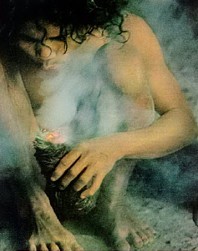
Prior to the closing of the preserve to visitors, PANAMIN funded essentially all efforts to find, visit, and study, the Tasaday, with most of the money used to “protect” them coming from Elizalde and his family, with a lesser portion provided by the Philippine government. As contact between the Tasaday and the world outside their forest virtually ceased with the banning of visitors to the preserve in 1976, so did expenditures on the Tasaday by PANAMIN. This is a great shame, for it is clear that Elizalde was initially genuinely interested in preserving the Tasaday environment from loggers. In 1983 Elizalde fled the Philippines. It had been rumoured that he fled with and eventually squandered millions of UN dollars from the foundation set up to protect the Tasaday. He died from leukaemia in 1999.
In 1986 the Marcos government was overthrown, and Oswald Iten, a Swiss journalist, accompanied and guided by a Filipino reporter named Joey Lozano, seized this opportunity to trek out into the jungle to find out what had become of the Tasaday. What Iten found shocked him, and soon became the basis for the hoax story.
Iten found the Tasaday’s caves empty and the tribe members living in huts nearby, dressed in jeans and t-shirts, living a simple, but certainly not especially primitive lifestyle. Upon questioning them (using Lozano as a translator), two of the Tasaday admitted to Iten that they weren’t really a ‘stone-age’ tribe and never had been. They claimed that Elizalde had pressured them into posing as one. “We didnt live in caves, only near them, until we met Elizalde,” they said. “Elizalde forced us to live in the caves so that we’d be better cavemen. Before he came, we lived in huts on the other side of the mountain and we farmed. We took off our clothes because Elizalde told us to do so and promised if we looked poor that we would get assistance. He gave us money to pose as Tasaday and promised us security from counter-insurgency and tribal fighting.”
“In retrospect, the fraud seemed obvious. Why, some wondered, were the caves so clean? Even a Stone Age tribe would have had garbage, such as crab shells or scraps of food. And how did such a small tribe avoid in-breeding? Also, the Tasaday were a mere three hours walk from a modern village. It seemed odd that they would not have encountered this village while searching for food.” (Robert Hemley, Invented Eden: The Elusive, Disputed History of the Tasaday)
“There are moments when it seems that the world’s affairs are transacted by dreamers. There is a sadness here in the spectacle of nations, no less than individuals, helping each other along with their delusions..” (James Hamilton-Paterson, America’s Boy)
The Tasaday hoax has shown that exaggeration by money and power-hungry politicians combined with the gullibility of scientists who turn a blind eye to the reality opposing their theories, along with donated money with no accountability, can lead to exploitation of incredible magnitude, and not just the Tasaday. One also begins to wonder how much of anthropological classics such as Coming of Age in Samoa by Margaret Mead may at best be taken as naively inaccurate.
(Photo: Lake Pinatubo, Luzon)
References/Resources http://oregonstate.edu/instruct/anth210/tashyp.html

